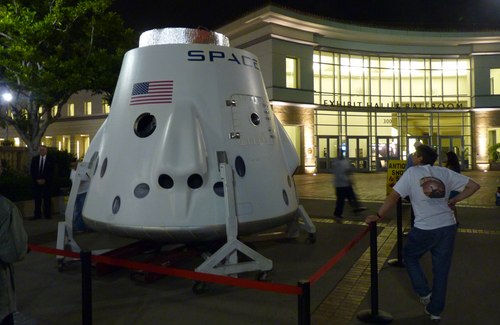
A mockup of the crewed version of the Dragon spacecraft on display in August 2012 outside the Pasadena Convention Center. SpaceX will unveil the actual crewed version of Dragon, called Draon V2, Thursday night. (credit: J. Foust)
SpaceX is holding a media event tonight at 7 pm PDT (0200 GMT Friday) to unveil its Dragon “V2″ (version 2) spacecraft, one that will be capable of flying people. Elon Musk will formally unveil the spacecraft in an event at the company’s Hawthorne, California, headquarters; the event will also be webcast by SpaceX.
SpaceX hasn’t disclosed many details about how the Dragon V2 will differ from the current version of Dragon that transports cargo to and from the station, beyond obvious changes like the inclusion of seats and controls for the crew. The Dragon will feature new “SuperDraco” engines that will power its launch escape system and also be used for propulsive landings on land (versus the splashdowns in the ocean that the current Dragon performs). SpaceX announced earlier this week that it completed qualification testing of the SuperDraco thruster at its McGregor, Texas, test site. That clears the way for a pad abort test later this year, one of the last remaining milestones in SpaceX’s Commercial Crew Integrated Capability (CCiCap) award from NASA’s Commercial Crew Program.
While that pad abort test, and a later in-flight abort test, will demonstrate the SuperDraco’s ability to get the Dragon away from a malfunctioning rocket, SpaceX is also planning tests of the thruster’s ability to allowed powered landings of Dragon. Earlier this month, the FAA’s Office of Commercial Space Transportation released a draft environmental assessment report of tests of the “DragonFly” system at McGregor. The report is part of a SpaceX application for an experimental permit to cover powered test flights by the Dragon capsule: “SpaceX’s need for the experimental permit is to conduct tests to further develop the capability for the Dragon capsule to land, so that it can be reused.”
According to the test program in the report, SpaceX plans to do a pair of “propulsive assist” landing tests, where Dragon is dropped from a helicopter form an altitude of about 3,000 meters to land using a combination of parachutes and SuperDraco thrusters. That would be followed by a pair of drop tests where the dragon will use its SuperDraco thrusters alone. That will be followed by as many as 26 “hopping” tests where the capsule takes off from a pad under thrusters and land back on that pad after flying to altitudes of a little more than 2,000 meters; those landings would initial be with parachutes and later with SuperDraco thrusters. Those tests would, under the permit, be performed in one year, although SpaceX notes in the report that it expects the DragonFly program to span two years, 2014 and 2015.

Leave a Reply